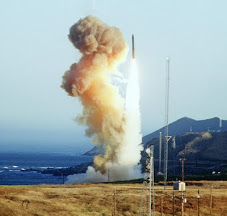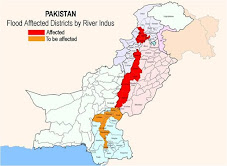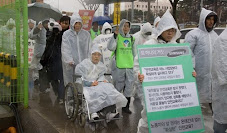During the two days of weekend, snow was constantly falling in the Gangjeong village. The excavations on the cultural properties have been posed during the weekend. Carrying on excavations are being done not necessarily same with the original registration map by the Jeju Cultural Heritage Institute. See the map here. The excavation team director has said to the villagers that he could only report the results on excavations to them, neither changed plans nor process on them and that the foundation had made a contract with the navy that all the contents on contract between the both would be classified, which really infuriated the villagers. The villagers are told from him that they can only visit and observe the excavation sites. So far, no relics were discovered but people need to watch the site by the end of excavation research days (which were counted 54 days starting from Jan. 25). If any remains, not relics are discovered, the navy should stop the construction.
On Sunday, snow was falling on the sites that would be continued with excavation works tomorrow as well.
 During the weekend, excavation reserach on cultural properties were also posed. (Jan. 29, 2011)
During the weekend, excavation reserach on cultural properties were also posed. (Jan. 29, 2011)
주말에는 문화제 발굴 조사가 중단이 되었습니다. (2011년 1월 29일) Jan. 30, 2011 (2011년 1월 30일)
Jan. 30, 2011 (2011년 1월 30일) Snow in an excavation trench. 발굴 갱도의 눈
Snow in an excavation trench. 발굴 갱도의 눈 Strings as the marks for excavations for this week. 이번주 발굴들을 위한 줃 표시
Strings as the marks for excavations for this week. 이번주 발굴들을 위한 줃 표시 Way to the Joongduk coast : The red letters on the road read, 'No U. S. base'
Way to the Joongduk coast : The red letters on the road read, 'No U. S. base'
 A navy construction mark. Whenever the villagers see the navy construction marks on the rocks in the Joongduk coast, they erase them and the navy mark them again. Then the villagers would do erase again.
A navy construction mark. Whenever the villagers see the navy construction marks on the rocks in the Joongduk coast, they erase them and the navy mark them again. Then the villagers would do erase again.  A Samsung-made security system(SECOM) is shown in front gate of the navy field office on Jan. 30, 2011. CCTVs have been also installed as well.
A Samsung-made security system(SECOM) is shown in front gate of the navy field office on Jan. 30, 2011. CCTVs have been also installed as well.  * Image source: Seogwipo Daily News paper, Jan. 30, 2011 서귀포 일간 신문, 2011년 1월 30일
* Image source: Seogwipo Daily News paper, Jan. 30, 2011 서귀포 일간 신문, 2011년 1월 30일
The City of Seogwipo and headquarter of the Jeju Defense Command, navy held an Olle-cleaning event on Jan. 29. This kind of civilian-military services seem to appease the villagers and Island people who are opposing naval base construction. A villager says the city and military should rather remove the currently completed navy field office in the Gangjeong village. The planned Jeju naval base is faked as the civilian-military complex tour beauty harbor, after all.
Snow in Gangjeong
It was snowing in Gangjeong village, Jeju Island on Jan. 30, 2011. The scene is the Joongduk coast where artists installed various art works to protect the village from the naval base construction. The sea is where the UNESCO designated soft coral inhibits and the rocky coast is told to be the only rocky wet land area in Korea as the underground water springs from the lava-molten rocks and meets with sea water. Dolphins come to this sea every June ~November in their migration.
강정의 눈
2011년 1월 30일 강정 마을에 눈이 왔습니다. 예술가들이 해군 기지 건설로부터 마을을 구하기 위해 다양한 예술 작품들을 설치한 중덕 해안입니다. 바다는 유네스코 지정 연산호가 군락하는 곳이며 용암이 녹은 바위들 밑에서 지하수가 올라와 바닷물과 만남에 따라 한국에서 유일한 바위 습지 지대라 말해집니다. 돌고래들이 매년 6~11월에 회유중 옵니다.
_______________________________________
The below is the partial translation of the opinion column by the editor of the Jeju Domin Ilbo on Jan. 30, 2011. He is reputing the address by Woo Keun-Min, the Island governor who said that the Island of Peace and Jeju naval base could go together on his Jan. 26 speech upon the 6th anniversary of the Jeju being designated as the Island of Peace. See Woo’s speech in video (Korean)
'In October, 2003, Roh Moo-Hyun, ex-President, officially apologizing to the Jeju Island people for April 3 [massacre and uprising event in 1948] which was defined as ‘the infringement on the human rights by the state power,’ through government truth investigation, suggested that “by subliming the important lesson of April 3, let’s extend the universal human values of peace and human rights, end all the divisions and confrontations through reconciliation and cooperation, and open the way for peace in the Korean peninsula and further in northeast Asia and the world.”
Following it, it was natural conclusion for the [Roh] government to designate and issue the Jeju as the World Peace Island on January [27], 2005. In 2007, Lee Hae-Chan, then the prime minister of ‘real power’ has said, “establishment of peace system in the northeast Asia’ is the completion of the Jeju as the World Peace Island.”
What is national security? The April 3 event in which innocent Island people have been sacrificed without knowing reasons, the Lee Seung-Man dictatorship regime, and the Yushin–military dictatorship regimes were those ghosts of the national security.
Is really the large-size construction of naval base with a maneuvering war unit including high-tech Aegis ship, 2 submarine war units and land support war unit(s), a business for national security and establishment of peace system in the northeast Asia? Why do you close your ears to such ‘uncomfortable truth’ that the Jeju, the World Peace Island dreaming an international freedom city is ‘at the risk to be the 2nd Okinawa’ with a naval base construction by being incorporated into the United States strategy of ‘ crescent siege ‘ against China, linked in Japan-Korea-India and being fallen amidst the world powers’ domination competition in the Northeast Asia, which has been told by the overseas media, domestic & foreign specialists, civic organizations and religious fields?
I ask and ask you again whether it is truly the way for the Jeju and Jeju Island people to say it is possible that naval base and World Island Peace can stand together, while you affirming your ‘loyalty’ to the unverified national logic and to the navy’s greed for oceanic power. '





























![[URGENT PLEA: In Update] EMERGENCY in GANGJEONG Since AUG. 24, 2011](https://blogger.googleusercontent.com/img/b/R29vZ2xl/AVvXsEiQvpaNf6EePZVucu97_JphYsFS5IgumnSiA4YAmen1PZcim6vMmW7XjZ7J6nLh-Cu36mwBN5n1evrA3ey0vYMpwlAGsgnSFggv6a1w4Qx9BvvqOB0hy0BIcBkL2Exfs3zIxBsBuDGa1kzg/s227/jejusit.jpg)



![[Solidarity from Japan for the Jeju] 253 individuals and 16 groups/organizations](https://blogger.googleusercontent.com/img/b/R29vZ2xl/AVvXsEivji7100kBkr0hzvqYfh4IBBilkZ6XgDIg89jOxS6kTssxsVKC6Wm-fZbKOEsiy3zcO-9gW6GHspD5R_2C9WsGx5S1Z5VPj_OVRF7H6dxdaT0S-2H1eqsDsYvIwOV26VscxTHnKmP5iZmh/s227/jeju_12_10j.jpg)

![[Translation] Korean organizations' statement: Immediately cancel the joint ROK-US drill Nov 26](https://blogger.googleusercontent.com/img/b/R29vZ2xl/AVvXsEgfKDMo-qyEjm5asUtHlREyJY_5Ou-2tyB8SH6aUxiViRbbKR-8W_rirFiGp5DYSoD_KaeNOPMWR0af0ZPUIbJKmR89ImDvADHsGAIqsJVBvJNBEIl5wLd3G_zhPDW3Z2SxsHXadOsXe8st/s227/1.jpg)
![HOT! [Hankyoreh Hani TV] Beneath the Surface: the investigation into the sinking of the Cheonan](https://blogger.googleusercontent.com/img/b/R29vZ2xl/AVvXsEh80rL3Qv9GnfHSqbYMfivdqX5gZN-1O_VQj3A_Gk3yjWdybHwJCsprA3l6cEQB0cYCP2oNeaLo2ohLGIy0Uqqkv_fRkBevGJ2f-qkKD5eP1ZGsKeQ-r-jHUUb79WvucIN7hpEtXza4xXCL/s227/HaniTV+Cheonan.gif)



![[Translation]Statement against illegal inspection and unjust lay-off by the Kunsan USAFK!(Nov_2010)](https://blogger.googleusercontent.com/img/b/R29vZ2xl/AVvXsEg3JlQ-lreusCIJo5Yv2e3ZrRwrSMUE7UQxlrDVjmBehl0Pa24QZIAbZ5vUpgnnExbkKL9PdCwxVYSHWJkr_XK0FM4EhU3CMFhqfborVNu_p4v3bEFpNm3ia-aEHnvMMuEBI27aB7_BETuJ/s227/gunsan+protest.gif)
![[Translation] Korean organizations' statement against dispatching special force to the UAE on Nov.](https://blogger.googleusercontent.com/img/b/R29vZ2xl/AVvXsEiU7TNhTDLLwZkKP0Z78JsCZKp6je-QSFll3_ThmLES_y_nPLXEzeakrsZXoNxhN5blopEhy6xGV2tneJrniPdTR-JvOQMmSLr_HhlucxFvbusxk4oKvvMO2laBOHSIkB9OOeOxrQlqCA0O/s227/antiwarpeace.jpg)
![[Translation] Stop, Joining MD!: South Korean activists' statement and writing on Oct. 25, 2010](https://blogger.googleusercontent.com/img/b/R29vZ2xl/AVvXsEggGIHVei8j7LCJPJB5HIrspd942q436daNTquP-pFd45Cl70Ml_1JFiFDHgKu6FcoqNgFVKIFqjeuSPau2k_BwGHhx0cqFFL2-4ybZSTlmua0_AsERBtKYQa7jZk7uNj41LX6rj2vksHbo/s227/StopMD.jpg)
![[In Update] People First, NO G-20 (Nov. 6 to 12, Korea)](https://blogger.googleusercontent.com/img/b/R29vZ2xl/AVvXsEhZl8VTqeL7o2ndliGIE-sZFCikbTgfB9KCc3AtZvDaYijBBEhdfultMEOpyrCaD5gzpH8mqfWjU20KXMbSUl-5KM7yQeHU6z3BWV8tiOy4UKaCudz9VKWoi5x58xdC_gQpJTjkR5u7O9xf/s227/left21_G20.jpg)
![[International Petition] Stop US helipad plan in Okinawa to save great nature](https://blogger.googleusercontent.com/img/b/R29vZ2xl/AVvXsEihgYmdb0N8ViPvTFC_5i-Psbt4eX_LnAUEOtZkUngv_pGvRyWag1r6W60NicLLyTgWq-sPT1hBxLY5SadEIVv5McfZQ5uIhe-W0VoflQNqojsYZjFW6AH-gB1jsmSDGnGuKIFk2UkvNbFG/s227/yanbaru_w.jpg)

![[Global Network] against the first launch of Quasi-Zenith Satellite, Japan, on Sept. 11, 2010](https://blogger.googleusercontent.com/img/b/R29vZ2xl/AVvXsEj2sYpfodDDMIA7qXwuda0DmKapxXFB479fDnn8RKy7QNZqz0VEvWucNd-DleZ37hWNXC-Z8QtaqtM37VuPwac5SgclJ9_khBBSWOedvm19MRXIP1j1kcWrK6EW5IFjQdEEY2h7E6xuyNvC/s227/Qzss-45-0_09.jpg)

![[In update] Some collections on the Koreans’ protests against the sanction & war on Iran](http://4.bp.blogspot.com/_gnM5QlRx-4c/TJMvke6t8zI/AAAAAAAAFO4/tamQ8LUnOOA/S227/No+Sanction+on+Iran.jpg)
![[Three International Petitions] to End the Korean war and peace treaty(or peace resolution)](https://blogger.googleusercontent.com/img/b/R29vZ2xl/AVvXsEhlohLVYtpCg7iMsZhNYY4hBbhTi2dIheHMHWLDph9X2y78cjgZV1LeSfUJeu80elhJm70Q9E059q72lK-spSPvsRG4bPuCDIytltJB9IH3mWt9OG98HqhnTsPakwhvNeoCFUgF1xoxQ2EZ/s227/border.jpg)



![[Collection of Documents] No Base Learning and Solidarity Program_Korea(June 14 to 20, 2010)](https://blogger.googleusercontent.com/img/b/R29vZ2xl/AVvXsEix_HzjToh3nNGHBc-_5gasq-ykcaZ6GInLixILmZVyRJ5xoeHCxWOyYd9fSM7bmnuFsjSrYOGEPnQOwB1Dcyo-sN4Pw0cFPhUtKig_qlVnGL1Wi82ClvPqbEPWYhJiqdNF0DyzLIBETMB9/s227/No-Base-banner.jpg)
![Site Fwd:[John Hines] A U.S. Debate coach’s research trip on the Issues of Korea](https://blogger.googleusercontent.com/img/b/R29vZ2xl/AVvXsEg8yRra0zNhKHN74Auqhd3Nx9tZ7BWCGflRJHGH4CfzBT_yjhZ8Nl9b3OZuLpYWJ2exsjmR0oVl-Qq_cf832p2VdmOZhUi-lCFzCNeDSyVtweX1lWZPC-RlHmDMLtilHwHjNFTenBiM4Fk4/s227/Jeju-Peace-Tour.jpg)


![[News Update] Struggle Against the Jeju Naval Base since Jan. 18, 2010](https://blogger.googleusercontent.com/img/b/R29vZ2xl/AVvXsEhKfSTRC5QKBBSFIq_m7QIqXdlbL4-gF5GJYn9Q-pN__k7sV7uxGDcLY5L8xmU7QuWuUhBT_GhG-URBPO80RT3AfWfDrWJr06h1hFuZC6ZBVKe4U6PS1Cd7Kr6olO8TYQtk13Drox7IS6ea/s226/scrum1.jpg)


![[Urgent] Please spread the Letter!: There was no Explosion! There was no Torpedo! (May 26, 2010)](https://blogger.googleusercontent.com/img/b/R29vZ2xl/AVvXsEhSd2yWZ3xGwnJQXB73z5FgXCqSosAoB9_33-GLYprOmLqjmvgSAQp1BYI7e4slK1FDxHRi9KK4um-OpDaj8QOkXwAScVAgvvq6-ehbDA-hbkr96wT9oHNNmWnBPv8GU4hoZp9X8F9AZBX4/s227/grounded.jpg)
![Text Fwd: [Stephen Gowans]The sinking of the Cheonan: Another Gulf of Tonkin incident](https://blogger.googleusercontent.com/img/b/R29vZ2xl/AVvXsEi_L6hB3RZ1MovTXHe0A8yn_RfgMALGR0kM6poBuGp809xwvHtB_-PGWtS_WpyPWatyd9lB2pPqL2gOLc4dTCEdJ9sMvxJWEdapl-mMLm7WHAsV-jVpgqarVh8XBtdz_0c-Vohdh3HtJahD/s227/lee-myung-bak.jpg)
![[Japan Focus]Politics in Command: The "International" Investigation into the Sinking of the Cheonan](https://blogger.googleusercontent.com/img/b/R29vZ2xl/AVvXsEiHmTo8v-uCJnabRhMdnBAkC9J3s5bb2JsDKiT5leJHwbK8IDJHxfJmqQ_C0Is_bPC6UGMf05CA0exF2y4r2x9RhFUHT0kjsKviaME_MZXKnq775UyYAdb7w2SAzE75XvBfHp1al2q6i3cf/s227/wen_jiabao_and_lee_myungbak.png)
![[Japan Focus] Who Sank the SK Warship Cheonan? A New Stage in the US-Korean War and US-China](https://blogger.googleusercontent.com/img/b/R29vZ2xl/AVvXsEiKSS5ULT5QBaMGYpXXqBMX9jtwLwMLuK469b6Ku72GTJYKUObzTANaPjZqvvpPzYMJgPF53sjhvhK3DVa88ipYlggsJageykXlkxY6s8TW05xcU-_vfhf-pACUoaWuFbT-fsU1qEhm_yIi/s227/buoy_map.gif)
![[Updated on 12/13/10] [Translation Project] Overseas Proofs on the Damages by the Military Bases](https://blogger.googleusercontent.com/img/b/R29vZ2xl/AVvXsEikADE6JovUNspQyZUWVMTLAQg7yQNqXpVUbqZPk8f4uc_1723_xm1Cco6WAmstQXVPnaJAcb1mZA8Ny_3xONT_f5uh8MNLPnUhtqdGgy3HCtC1Vbbz4Q0ZY1Cssu-4cJEVNdrvznbS5UzO/s227/missile.jpg)
![[International Petition] Close the Bases in Okinawa](https://blogger.googleusercontent.com/img/b/R29vZ2xl/AVvXsEhNpQiHklwFbWVlFK7GDFXnBSOOSFEj3Il-We-N3uTDldKiidL2NGZs7X_LtTnatzTo_r8CexRkFe8NhfxYqmgp1knEEslROTfNjI5_mSb57cdbhPkftvanveYBaevAD9xuKDGoIxiTwoSb/s227/2.jpg)

![[In Update]Blog Collection: No Korean Troops in Afghanistan](https://blogger.googleusercontent.com/img/b/R29vZ2xl/AVvXsEjjEmCRXSNAG7_QBxKWbdksmxoWR4nyAovQTTdR1G2AuXh0jxtqNkI9OmYgYWRoLAJShvtBvE840QXuBWSVh3u3zMYqkNAFX6OWy3m5Nur4HM7uNK-pKT1ycyApJp-VLyhIFRRcoisYAh0E/s226/No-Troops-to--Afghanistan.jpg)










